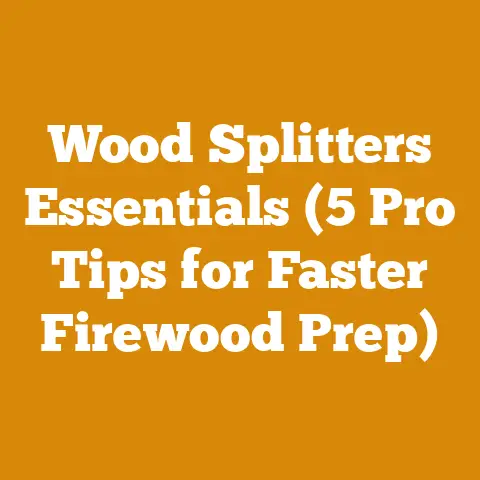Can a Chimney Flue Run Horizontally? (5 Pro Tips for Safe Installation)
In recent years, I’ve noticed a surge in homeowners embracing the charm and efficiency of wood-burning stoves and fireplaces. It’s a trend fueled by a desire for sustainable heating solutions and a connection to more traditional ways of life. However, this resurgence brings with it a critical need for understanding the intricacies of chimney systems, especially when dealing with unconventional installations like horizontal flue runs. I’ve seen firsthand the costly and dangerous consequences of neglecting proper flue design, and that’s why I’m dedicated to providing clear, practical guidance to ensure safe and efficient wood burning practices.
Can a Chimney Flue Run Horizontally? (5 Pro Tips for Safe Installation)
The short answer is yes, a chimney flue can run horizontally, but it’s significantly more complex and less ideal than a vertical run. It’s a situation that demands meticulous planning, adherence to strict safety codes, and a deep understanding of how flue gases behave. A horizontal run introduces numerous challenges, primarily related to draft, creosote buildup, and the increased risk of chimney fires.
I’ve been involved in several projects where horizontal flue sections were necessary due to architectural constraints, and I can tell you from experience that cutting corners is not an option. The stakes are simply too high. Let’s delve into the five crucial tips for safe and successful horizontal flue installation.
Understanding the Physics of Chimney Draft
The Driving Force: Buoyancy and Temperature
Before diving into the tips, it’s essential to grasp the fundamental principle behind chimney draft. Hot flue gases are less dense than the surrounding air. This density difference creates buoyancy, causing the gases to rise through the chimney. This natural draft is crucial for efficiently removing combustion byproducts and preventing smoke from entering your home.
A vertical chimney maximizes this buoyancy effect, while a horizontal run significantly diminishes it. This is because the horizontal section offers resistance to the upward flow of gases, reducing the overall draft. Inadequate draft can lead to:
- Backdrafting: Smoke and dangerous gases entering the living space.
- Inefficient Combustion: Reduced heat output and increased fuel consumption.
- Creosote Buildup: A higher risk of chimney fires.
The Stack Effect: Height Matters
The height of your chimney, often referred to as the “stack height,” is a critical factor in determining draft. A taller chimney generates a stronger draft than a shorter one. Industry standards, such as those outlined by the National Fire Protection Association (NFPA) in their NFPA 211 standard, typically require a minimum chimney height of 3 feet above the highest point where it passes through the roof and at least 2 feet higher than any portion of the building within 10 feet.
This height requirement is even more critical when dealing with horizontal flue sections. The horizontal run effectively reduces the overall stack height, necessitating a taller vertical section to compensate for the loss of draft.
Data Point: Studies have shown that a 10% reduction in stack height can lead to a 20-30% decrease in draft performance.
Tip #1: Minimizing Horizontal Run Length
The “Less is More” Principle
The golden rule for horizontal flue runs is to keep them as short as humanly possible. Every inch of horizontal flue introduces resistance to the airflow, hindering the draft and increasing the risk of creosote accumulation.
Specification: As a general guideline, I always advise aiming for a horizontal run that is no more than 75% of the vertical height of the chimney. For instance, if your chimney has a vertical rise of 10 feet, the horizontal run should ideally be no longer than 7.5 feet. However, local building codes should always be consulted, as they may have stricter limitations.
Personal Experience: I once consulted on a project where the homeowner attempted a 12-foot horizontal run with only an 8-foot vertical rise. The result was disastrous. The stove smoked constantly, and creosote buildup was alarmingly rapid. We ultimately had to redesign the system to incorporate a taller chimney and a shorter horizontal section.
Mitigating Factors: Increasing Chimney Height
If a longer horizontal run is unavoidable due to structural limitations, you can compensate by increasing the overall height of the chimney. This will improve the draft and help overcome the resistance introduced by the horizontal section.
Technical Requirement: For every foot of horizontal run exceeding the recommended limit, I typically suggest adding at least 1.5 feet to the vertical chimney height. This is a rule of thumb based on my experience, but it’s crucial to consult with a qualified chimney professional for a precise calculation based on your specific situation.
Tip #2: Maintaining Proper Slope
The Importance of Gradual Ascent
Horizontal flue sections should never be perfectly level. Instead, they should be installed with a slight upward slope towards the chimney. This slope helps gravity assist the flow of flue gases and prevents creosote and condensation from pooling in the horizontal section.
Measurement: I recommend a minimum slope of ¼ inch per foot of horizontal run. This means that for every foot of horizontal flue, the flue should rise by at least ¼ inch.
Practical Tip: Use a level and a ruler to ensure accurate slope during installation. I often use shims to fine-tune the angle and ensure a consistent upward gradient.
Preventing Creosote Traps
A level or downward-sloping horizontal flue creates a “creosote trap.” Creosote, a highly flammable byproduct of wood combustion, condenses and accumulates in these traps, significantly increasing the risk of chimney fires. Moreover, the accumulated creosote can obstruct the flue, further reducing draft and exacerbating the problem.
Data Point: According to the Chimney Safety Institute of America (CSIA), creosote is a leading cause of chimney fires in the United States. Regular chimney inspections and cleaning are essential to remove creosote buildup and prevent fires.
Tip #3: Selecting the Right Chimney Liner
Material Matters: Stainless Steel vs. Clay
The choice of chimney liner is crucial for safe and efficient wood burning, especially when dealing with horizontal flue sections. While clay tile liners are common in older chimneys, they are not ideal for wood-burning stoves and fireplaces, particularly with horizontal runs.
Specification: I strongly recommend using a stainless steel chimney liner for wood-burning appliances. Stainless steel liners offer several advantages over clay tile liners:
- Durability: Stainless steel is more resistant to cracking and deterioration caused by heat and acidic flue gases.
- Smooth Surface: The smooth surface of stainless steel reduces creosote buildup compared to the rough surface of clay tile.
- Flexibility: Stainless steel liners can be easily adapted to accommodate offsets and horizontal runs.
- Corrosion Resistance: High-grade stainless steel is highly resistant to corrosion, ensuring a longer lifespan.
Technical Requirement: Opt for a 304 or 316 grade stainless steel liner. 304 stainless steel is suitable for most wood-burning applications, while 316 stainless steel offers superior corrosion resistance and is recommended for appliances that burn fuels with high sulfur content.
Insulation: Minimizing Condensation
Insulating the chimney liner is another critical step, especially when dealing with horizontal flue sections. Insulation helps maintain higher flue gas temperatures, reducing condensation and creosote buildup.
Practical Tip: Wrap the stainless steel liner with a listed chimney insulation wrap before installing it in the chimney. Ensure that the insulation is properly secured and that there are no gaps or voids.
Data Point: Insulating a chimney liner can reduce creosote buildup by as much as 50%, according to some studies.
Tip #4: Ensuring Airtight Connections
Preventing Leakage and Backdrafting
Airtight connections are paramount for a safe and efficient chimney system. Any leaks in the flue can compromise the draft, allowing smoke and dangerous gases to escape into the living space. This is particularly critical in horizontal flue sections, where the reduced draft makes the system more susceptible to leakage.
Technical Requirement: Use high-temperature sealant and clamps to ensure airtight connections between all flue sections. I recommend using a sealant specifically designed for chimney applications, as it can withstand the high temperatures and corrosive flue gases.
Personal Experience: On one project, I discovered a small leak in a horizontal flue section that was causing significant backdrafting. The homeowner had used a generic sealant that had deteriorated over time, creating a pathway for smoke and gases to escape. Replacing the sealant with a high-temperature product and tightening the clamps completely resolved the issue.
Pressure Testing: Verifying Airtightness
After installing the chimney liner and connecting all flue sections, I always recommend conducting a pressure test to verify the airtightness of the system. This test involves sealing the chimney and pressurizing it with air. Any leaks can be detected by monitoring the pressure drop or by using a smoke stick to identify the source of the leak.
Technical Requirement: Consult with a qualified chimney professional to perform a pressure test and ensure that your chimney system meets the required airtightness standards.
Tip #5: Regular Inspection and Maintenance
The Key to Long-Term Safety
Even with a properly installed horizontal flue, regular inspection and maintenance are essential for ensuring long-term safety and efficiency. Creosote buildup is inevitable, and regular cleaning is necessary to prevent chimney fires.
Schedule: I recommend having your chimney inspected at least once a year by a certified chimney sweep. If you burn wood frequently, you may need to have it inspected and cleaned more often.
Personal Story: I had a client who dismissed the need for annual chimney inspections, claiming that he only burned wood occasionally. One winter, he experienced a significant chimney fire that caused extensive damage to his home. The fire was caused by a buildup of creosote in the horizontal flue section, which had not been cleaned in several years. This incident underscored the importance of regular inspection and maintenance, regardless of how often you use your wood-burning appliance.
Self-Inspection Tips
Between professional inspections, you can perform some basic self-inspections to monitor the condition of your chimney.
- Visual Inspection: Check the chimney exterior for any signs of damage, such as cracks, spalling, or loose bricks.
- Smoke Test: Light a small fire in your appliance and observe the smoke exiting the chimney. A strong, steady plume of smoke indicates good draft. Weak or erratic smoke suggests a potential problem.
- Creosote Check: Use a flashlight to inspect the inside of the flue for creosote buildup. If you see a significant accumulation of creosote, schedule a professional cleaning immediately.
Wood Selection and Moisture Content
The type of wood you burn and its moisture content also significantly affect creosote buildup.
Specification: Always burn seasoned hardwoods with a moisture content of 20% or less. Green wood contains high levels of moisture, which leads to incomplete combustion and increased creosote production.
Practical Tip: Use a wood moisture meter to check the moisture content of your firewood before burning it. Split a piece of wood and measure the moisture content on the freshly exposed surface.
Data Point: Burning wood with a moisture content above 20% can double the rate of creosote buildup.
Additional Considerations for Horizontal Flue Runs
Cleanout Access
Ensure easy access to the horizontal flue section for cleaning. A cleanout tee with a removable cap should be installed at the lowest point of the horizontal run to allow for easy removal of creosote and debris.
Support Structure
Horizontal flue sections must be properly supported to prevent sagging and potential damage. Use appropriate hangers or straps to securely support the flue at regular intervals.
Clearance to Combustibles
Maintain proper clearance to combustible materials around the chimney and flue. Follow the manufacturer’s instructions and local building codes to ensure adequate clearance.
Professional Consultation
Installing a horizontal flue is a complex undertaking that requires expertise and experience. I always recommend consulting with a qualified chimney professional before undertaking such a project. A professional can assess your specific situation, provide expert advice, and ensure that the installation meets all applicable safety codes and regulations.
Case Study: Horizontal Flue Installation in a Historic Home
I was recently involved in a project involving the installation of a wood-burning stove in a historic home. The home’s existing chimney was located on an exterior wall, and due to architectural constraints, a short horizontal flue section was necessary to connect the stove to the chimney.
Challenges:
- Limited space for the horizontal run.
- Maintaining the historic integrity of the home.
- Ensuring proper draft with the horizontal section.
Solutions:
- We minimized the horizontal run to just under 6 feet.
- We used a stainless steel chimney liner with insulation to maximize draft and minimize creosote buildup.
- We installed a cleanout tee at the lowest point of the horizontal run for easy cleaning.
- We carefully concealed the horizontal flue section behind a custom-built enclosure that blended seamlessly with the home’s historic architecture.
Results:
The installation was a success. The wood-burning stove operated efficiently and safely, providing supplemental heat to the home without compromising its historic character. The homeowner was extremely satisfied with the results.
Conclusion: Safety First
Installing a horizontal chimney flue requires careful planning, meticulous execution, and a thorough understanding of chimney dynamics. While it’s possible to achieve a safe and efficient installation with a horizontal run, it’s crucial to prioritize safety and consult with qualified professionals. By following these five pro tips and adhering to local building codes, you can enjoy the warmth and ambiance of a wood-burning appliance without compromising the safety of your home and family. Always prioritize safety and seek professional guidance when needed.






